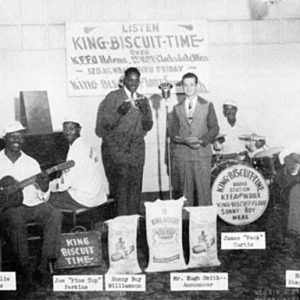calsfoundation@cals.org
Houston Stackhouse (1910–1980)
aka: Houston Goff
Houston Stackhouse never achieved much in the way of success, yet he was a pivotal figure on the southern blues scene from the 1930s through the 1960s, having worked with numerous significant blues musicians during that period, mentoring more than a few. He was a familiar figure in the small country juke joints, mainly in Arkansas and Memphis, Tennessee, and was highly respected among his fellow musicians. He also achieved a measure of regional fame as a member of the King Biscuit Boys who played on station KFFA out of Helena, present-day Helena-West Helena (Phillips County). When he finally made his first recordings in 1967, he was still a working musician, taking jobs within a 150-mile radius of his home base in Helena.
Houston Stackhouse was born Houston Goff on September 28, 1910, the son of Garfield Goff from Wesson, Mississippi. He only learned of his parentage and name at birth in the 1970s while trying to obtain a passport. He was raised on the Randall Ford Plantation by James Wade Stackhouse. As a youngster, he heard music from fiddler Lace Powell, who lived on the plantation, and two visiting uncles. His musical education began when the family moved a few miles north to Crystal Springs around 1925 and encountered the brothers Tommy, Mager, and Clarence Johnson. In addition to learning from the Johnson brothers, he was inspired by local musicians, as well as the records of Blind Lemon Jefferson, Lonnie Johnson, and Blind Blake. He launched his own career in the mid-to-late 1930s playing all over Mississippi, Arkansas, and Louisiana and working with musicians such as the Chatmon brothers (who performed as the Mississippi Sheiks), Robert Johnson, Charlie McCoy, Walter Vinson, and others. His two most enduring partnerships from this period were with Carey “Ditty” Mason and his cousin Robert McCollum—better known as Robert Nighthawk, whom he taught how to play guitar.
In 1946, Nighthawk asked Stackhouse to join him in Helena, where Stackhouse stayed for almost twenty-five years. For a year, he was a member of Nighthawk’s band, playing throughout Arkansas and Mississippi and on KFFA radio promoting Mother’s Best Flour. After splitting with Nighthawk in 1947, he joined with drummer James “Peck” Curtis, who was working on KFFA’s King Biscuit Time alongside guitarist Joe Willie Wilkins and pianists Robert Traylor and Pinetop Perkins. In 1948, Sonny Boy Williamson rejoined the show, and the group performed all over the Delta, using radio spots to promote their appearances. Stackhouse played with all the important musicians who passed through Helena, including Jimmy Rogers and Sammy Lawhorn, both of whom he tutored on guitar, as well as Elmore James, Earl Hooker, Willie Love, Ernest Lane, and Roosevelt Sykes. While he was an active blues musician at night, he worked days at the Chrysler plant in West Memphis (Crittenden County) between 1948 and 1954.
Unlike many of his fellow bluesmen, Stackhouse remained in the South, continuing to perform locally as well as working regular jobs through the 1950s. He continued to play with notable musicians through the 1960s, including Boyd Gilmore, Houston Boines, Frank Frost, and Baby Face Turner. In 1965, Sonny Boy Williamson returned to Helena and enlisted Stackhouse to join him once again on King Biscuit Time. That May, the group was recorded live by Chris Strachwitz of Arhoolie Records, a recording subsequently released under Williamson’s name as King Biscuit Time. Williamson died shortly after that recording, and Stackhouse continued briefly on the program with former partner Robert Nighthawk.
In 1967, field researcher George Mitchell recorded Stackhouse in Dundee, Mississippi. The group, calling themselves the Blues Rhythm Boys, consisted of Peck Curtis and Nighthawk. These were the final recordings of Nighthawk, who died a few months later. A week later, field researcher David Evans recorded Stackhouse in Crystal Springs with longtime partner Ditty Mason. With the death of Mason in 1969 and Curtis the following year, Stackhouse moved to Memphis in 1970, where he lived with Joe Willie Wilkins and Wilkins’s wife, Carrie. He began taking part in the blues revival, touring with Wilkins throughout the decade as the King Biscuit Boys, traveling with the Memphis Blues Caravan, playing various festivals, and making a lone trip overseas to Vienna, Austria, in 1976. He recorded for Adelphi in 1972, with various live tracks appearing on compilations. Outside of playing the first two Delta Blues Festivals in Greenville, Mississippi, he largely retired from music after his European tour and moved to Crystal Springs.
Stackhouse returned to Helena, where he died on September 23, 1980, at the Helena Hospital, having outlived most of his peers. A son, Houston Stackhouse Jr., survived him. On September 26, 2012, Stackhouse was honored with a Mississippi Blues Trail marker.
For additional information:
Evans, David. CD liner notes for Big Road Blues. Wolf Records, 1999.
“Houston Stackhouse.” Mississippi Blues Trail. http://www.msbluestrail.org/blues-trail-markers/houston-stackhouse (accessed April 27, 2022).
O’Neal, Jim, and Amy van Singel, eds. The Voice of the Blues—Classic Interviews from Living Blues Magazine. New York: Routledge, 2002.
Jeff Harris
Rochester, New York
 Arts, Culture, and Entertainment
Arts, Culture, and Entertainment Early Twentieth Century, 1901 through 1940
Early Twentieth Century, 1901 through 1940 King Biscuit Time
King Biscuit Time 




Comments
No comments on this entry yet.